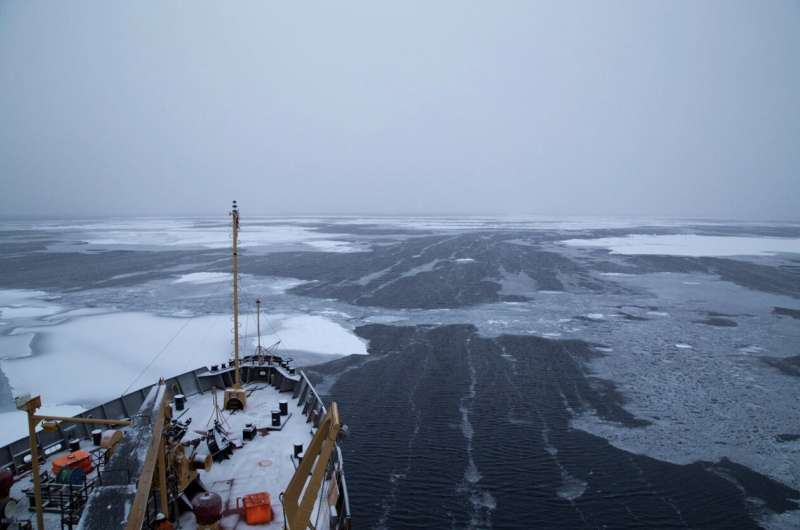
Arctic Ocean in October 2015, when the ocean’s surface is beginning to freeze.
A warming environment is causing a decrease in ocean ice in the Icy Sea, where loss of ocean ice has significant natural, financial and environment influences. On top of this drawn out shift because of environmental change are climate occasions that influence the ocean ice from multi week to another.
The most grounded Icy tornado at any point noticed poleward of 70 degrees north scope struck in January 2022 upper east of Greenland. Another investigation drove by the College of Washington shows that while weather conditions conjectures precisely anticipated the tempest, ice models genuinely misjudged its effect on the area’s ocean ice.
The review, distributed in October in the Diary of Geophysical Exploration: Climates, recommends that current models misjudge the effect of huge waves on ice floes in the Icy Sea.
“The deficiency of ocean ice in six days was the greatest change we could track down in the verifiable perceptions beginning around 1979, and the area of ice lost was 30% more noteworthy than the past record,” said lead creator Ed Blanchard-Wrigglesworth, an examination partner teacher of barometrical sciences at the UW. “The ice models anticipated some misfortune, however just about portion of what we found in reality.”
Exact ocean ice estimates are significant wellbeing devices for Northern people group, sailors and others working in Cold waters. The exactness of estimates in the Cold Sea likewise makes more extensive impacts.
“The expertise of a weather conditions estimate in the Icy influences the ability of weather conditions gauges in different spots,” Blanchard-Wrigglesworth said.
The January 2022 typhoon had the least tension place assessed since satellite records started in 1979 over 70 degrees north. It was an outrageous variant of an ordinary winter storm. Environmental change doesn’t seem liable for the typhoon: The scientists didn’t track down a pattern in that frame of mind of extraordinary Cold twisters starting around 1979, and ocean ice region was near the verifiable typical for that district before the tempest hit.
During the tempest, record twists yelled over the Icy Sea. The waves developed to 8 meters (26 feet) tall in untamed water and remained areas of strength for shockingly they went through the ocean ice. The ice hurled 2 meters (6 feet) all over close to the edge of the pack, and NASA’s ICESat-2 satellite shows that the waves came to the extent that 100 kilometers (60 miles) around the focal point of the ice pack.
Six days after the tempest struck, the ocean ice had diminished fundamentally in the impacted waters north of Norway and Russia, in places losing the greater part a meter (around 1.5 feet) of thickness.
“It was a beast storm, and the ocean ice got pulverized. Furthermore, the ocean ice models didn’t foresee that misfortune, which proposes there are ways we could work on the model physical science,” said second creator Melinda Webster, an examination partner teacher at the College of The Frozen North Fairbanks. She starts an examination position in the new year at the UW Applied Material science Research center.
The new examination shows that the environmental intensity from the tempest made a little difference, meaning some other component was to be faulted for the ice misfortune. Conceivable outcomes, Blanchard-Wrigglesworth recommends, incorporate ocean ice that was more slender before the tempest hit than models had assessed; that the tempest’s waves poor up ice floes more strongly than models anticipated as they infiltrated profound into the ice pack; or that waves beat up more profound, hotter water and carried it into contact with the ocean ice, liquefying the ice from underneath.
The startling ice misfortune, regardless of an exact tempest gauge, proposes that here models could move along. The scientists desire to screen future tempests to pinpoint precisely exact thing prompted the sensational ocean ice misfortune, possibly by putting sensors in the way of a future moving toward storm.
While this tempest doesn’t have all the earmarks of being connected to environmental change, a rising measure of vast water as ocean ice softens is taking into consideration bigger waves that are dissolving Cold shores. Those waves, analysts said, could likewise influence the leftover ocean ice pack.
“Going into the future, this is something to remember, that these outrageous occasions could deliver these episodes of tremendous ocean ice misfortune,” Blanchard-Wrigglesworth said.
Other co-creators are Linette Boisvert at NASA, Chelsea Parker at NASA and the College of Maryland and Christopher Horvat at the College of Auckland and Earthy colored College.



